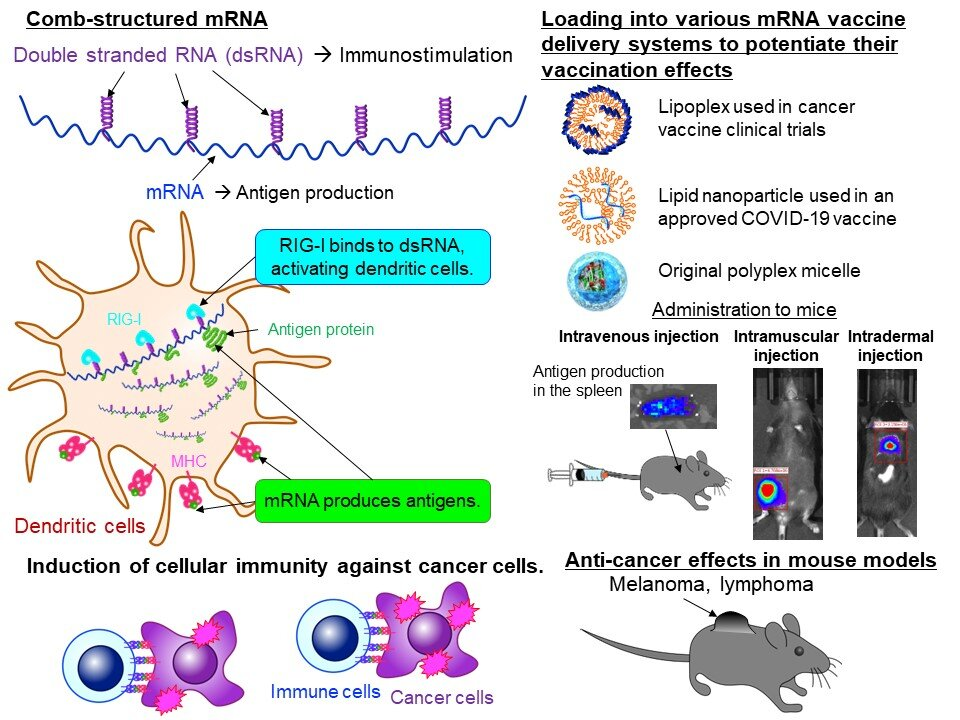The mRNA COVID-19 vaccine has allowed us to witness the effectiveness, safety and great potential of mRNA technology. Currently, research institutions around the world are targeting cancer as the next target for mRNA technology. mRNA cancer vaccines activate cellular immunity to attack cancer cells by producing proteins (i.e., tumor antigens) specifically expressed in cancer cells. However, cancer cells are not easily distinguishable from normal cells, and cancer cells are immunosuppressive, making the development of mRNA cancer vaccines more challenging than mRNA infectious disease vaccines. Therefore, it is necessary to improve the efficacy of mRNA cancer vaccines, and enhancing immune activation through adjuvants is an effective strategy. But if the adjuvant is too strong, it will cause adverse reactions. An adjuvant that is too weak does not provide sufficient activation. Previous mRNA vaccines all have adjuvant effects, but there is a lack of rational and practical methods to obtain controllable adjuvant activity. Researchers from the Kawasaki Institute of Industrial Promotion in Japan published a research paper titled "Comb-structured mRNA vaccine tethered with short double-stranded RNA adjuvants maximizes cellular immunity for cancer treatment" in the Proceedings of the National Academy of Sciences. The study constructed a brand-new mRNA structural form, combining the single-stranded mRNA sequence encoding the antigen with the double-stranded RNA (dsRNA) to form a comb-like structure, in which the single-stranded mRNA is responsible for producing the antigen, and the dsRNA acts as an assistant. It can further activate immune cells, and has shown high anti-tumor effects in melanoma and lymphoma model mouse experiments. The intensity of immune stimulation can also be controlled by adjusting the amount of dsRNA, so as to achieve controllable adjuvant activity and ensure safety while improving vaccine efficacy. In this study, the research team used mRNA engineering techniques to develop a method to directly incorporate an adjuvant into single-stranded mRNA encoding an antigen without interfering with its ability to produce the antigenic protein. The research team designed a short dsRNA targeting the natural immune receptor RIG-I, and loaded it onto the single strand of mRNA by hybridization, thereby obtaining a comb-structured mRNA. By changing the dsRNA length and sequence, are able to efficiently activate RIG-1. Comb-structured mRNA generated by this method efficiently activates dendritic cells (DCs), which play an important role in vaccine efficacy. In addition, the intensity of immune stimulation can also be controlled by changing the amount of dsRNA bound to the single strand of mRNA. This is critical to achieve adequate vaccine efficacy while preventing excessive immune activation and ensuring safety. Next, the research team evaluated the effect of this new mRNA cancer vaccine in tumor mouse models. The results showed that when comb-structured mRNAs were loaded onto lipid nanoparticles (LNPs) used in clinical trials of cancer vaccines, the cellular immune activity necessary to attack cancer cells was significantly enhanced. In mouse models of melanoma and lymphoma, the tumors were significantly reduced in size and their lifespan was significantly extended.
Figure 1. Comb-structured mRNA and its immunological activities.
Furthermore, this comb-structured mRNA can also be loaded into various mRNA vaccine delivery systems to enhance their potency. The research team loaded the comb-shaped mRNA into the LNP used to deliver the mRNA COVID-19 vaccine, as well as the polymer nanomicelle developed by the team, which can improve the vaccine effect. This shows that comb-structured mRNA can be used as a simple and practical mRNA technology platform to safely improve the efficacy of various formulations of mRNA cancer vaccines by freely controlling the adjuvant function of mRNA vaccines. The adjuvant function, which is crucial for mRNA cancer vaccines, has so far not been able to precisely control and rationally incorporate it into vaccine design. As a result, researchers have had to rely on experience, testing large numbers of candidate compounds in animal experiments, complicating the vaccine development process. This latest study incorporated the rationally necessary adjuvant functions directly into mRNA vaccines through mRNA engineering. With this approach, the adjuvant function can be easily incorporated into various mRNA vaccine delivery systems to enhance the effect of cancer vaccines. Overall, the research team developed a new mRNA structure, the comb-structured mRNA, and demonstrated its efficacy in various mRNA vaccine delivery systems. This comb-structured mRNA is a multifunctional system that could enhance the potency of any mRNA vaccine under development. As the next generation of cancer immunotherapy, the world is accelerating the development of mRNA cancer vaccines, and comb-structured mRNA is expected to become the core basic technology to improve its efficacy. Reference 1.Tockary T A, et al. Comb-structured mRNA vaccine tethered with short double-stranded RNA adjuvants maximizes cellular immunity for cancer treatment. Proceedings of the National Academy of Sciences, 2023, 120(29): e2214320120.


